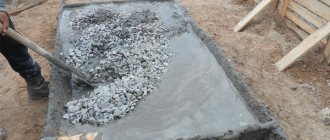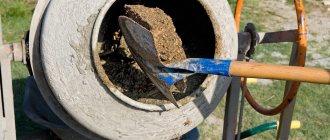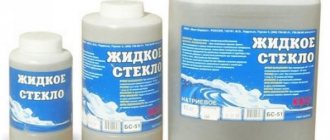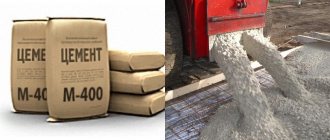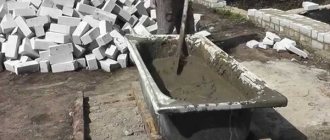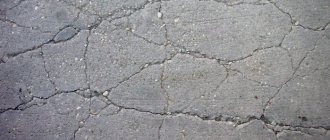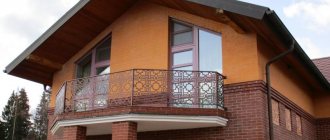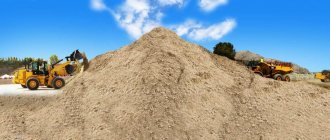Concrete is one of the most versatile and common materials for pouring foundations. Its preparation is fraught with a number of difficulties, in particular, maintaining proportions and choosing high-quality ingredients for preparing the composition. In this article we will try to outline a number of recommendations that can help you make the optimal solution for the foundation with your own hands, using the most commonly used measuring unit - a bucket.
Application of concrete
Look around: the vast majority of all structures are built on a concrete foundation, but this is not even the most remarkable thing.
- Walls,
- Scenery,
- load-bearing beams and the like are made of concrete or some part of its inclusions.
Taking this fact into account, of course, we can say that this mixture is used in almost all areas of not only construction, but also repairs, laying railways, strengthening dangerous objects, etc.
How to build a toilet in a country house with your own hands: drawings, location, insulation, ventilation, lighting.
Storage plastic septic tanks: advantages and disadvantages, installation features.
Details on how to flush a well with your own hands: causes of blockage, cleaning options, prices.
Since this material has varieties, the choice of which directly depends on the purpose of the object for which it is used and the area of laying, that is, for the foundation, walls or just decoration, then we will talk about the areas of its application in relation to general information, and go deeper - already in subsequent paragraphs.
The main areas of use of the cement mixture are:
- Construction and repair industries;
- Industry;
- Railway works;
- Military industry;
- Design;
- Mining production;
- Energy and oil industries.
Note that in the military, mining and construction fields, as a rule, reinforced materials are used, since it is necessary to give the structure not only strength, but also hardness: a mixture pierced with steel pins gives much less chips and cracks when subjected to strong impact.
Varieties
There are more than 30 types of cement in the construction industry. The most commonly used types are:
- An important hydraulic material in construction is Portland cement . It is made from crushed gypsum and clinker. It has actively increasing strength during hardening. It is used in the production of reinforced concrete structures and durable foundations.
- Colored cement is made from white clinker and various colored pigments: ocher or chromium oxide. It is used in the decorative design of buildings.
- Hydrophobic foundation cement has lower water absorption and high frost resistance It is made from crushed clinker, water-repellent additives and gypsum. It is used in conditions of high humidity and harsh climatic conditions.
- Slag material is used for the manufacture of foundations and building mixtures . It is obtained by mixing various additives and blast furnace slags.
- In the manufacture of reinforced concrete structures, quick-hardening . It consists of various additives and crushed clinker.
There are many types of cement, so when choosing a material for a foundation, the most important parameter is the brand of cement for the foundation. Each of them has a certain strength class and frost resistance.
Return to content
Composition of concrete for the foundation
All physical properties of the concrete composition completely depend on what was added to it during production (that is, to the finished mixture), or when mixed independently. Let's look at each component separately.
Cement
Its quality is controlled using TP-166-04, GOST 31108-2003 and SNiP 2.03.11-85. Really high-quality cement is subject to very serious criteria, by which one can judge both the integrity of the manufacturer and the characteristics of the concrete mixture as a whole. So, good cement has a grinding fineness of 350-380 m2/kg, although it may differ slightly from this parameter, but not more than 10%. It should begin to set, if we take the average value for the construction area, in 2-3 hours, and finish in 4-5 hours. It is also desirable that the density of the cement paste does not exceed 25-27% water from the total mass of the mixture. The alkali in it should be no more than 0.6% of the total mass.
ASG and other fillers
Its role can be played by either sand or gravel (crushed stone), or their combinations, which are also determined by GOSTs and SNiPs. The filler is required for the following purposes: giving greater strength to the composition and reducing the cost of its use due to the fact that not the entire volume is occupied by cement (sand and gravel with crushed stone are cheaper).
Construction sand is a fine aggregate, which differs from ordinary river sand in that its grains of sand have a slightly more regular rounded shape, and a little clay is included in the sand mixture itself to give the final mixture plasticity and softness.
The largest aggregate in the composition is crushed stone, gravel or granite chips. Their choice is based on what strength is required: for the strongest grades of concrete (for example, M500) only granite chips are used, for weaker grades (from M350 to M100, they are used, as a rule, for the composition of concrete for the foundation) - gravel and crushed stone.
Water
It is the second most important component in the composition after cement. To mix the mixture, ordinary water is used, but resorting to rather sophisticated calculations, which take into account the water absorption of aggregates, the cement itself, and additives with various inclusions, which makes it possible to achieve the required consistency of the construction dough.
Additives and plasticizers
These include any impurities that help give the composition any properties or speed up the processes occurring inside it. For example, plasticizers increase the strength and mobility of a material, making it less susceptible to fracture due to tensile stress. There are additives that can give concrete frost-resistant, fire-resistant and moisture-proof properties in the right proportions, as well as speed up the hardening process or increase strength. The choice of additives depends only on the need for their use in a particular case.
Types of additives
For strength and durability of the base, as well as to improve performance characteristics, various substances are used in the preparation of the working solution. All additives available today can be divided into several categories:
- Plasticizers. They allow you to use less liquid during the preparation of the solution. Such a foundation will freeze less in winter and will not sag after several years of operation of the building.
- Antifreeze additives. They are used to work at sub-zero temperatures, preventing the composition from hardening in the cold.
- Seals. They are used to increase the strength of raw materials when constructing walls of small thickness.
- Strength gain accelerators. They are used in the construction of structures in a short time. In this case, the cement quickly gains the necessary strength after pouring.
- Retarders. They are used when transporting raw materials over long distances. They allow you to keep the cement in a liquid state.
In some cases, universal additives are used. They combine several properties at once and allow you to obtain material of the required quality.
Brands and marking of concrete
In order to select the most suitable concrete for any construction or production purpose, GOSTs required its manufacturers to indicate the most important characteristics of the mixture. Here it is also necessary to note the difference between the finished mixture and the dry one:
- the first is already hardened blocks,
- the second is the composition whose proportions of concrete in buckets for a concrete mixer must be calculated directly at the construction site.
The most important indicators of composition quality include:
- Brand - M;
- Frost resistance - F;
- Mobility - P;
- Water permeability - W;
- Class - B.
As a rule, buyers look only at the brand and class of composition, forgetting about other indicators, which often becomes a critical mistake.
After all, even durable material with high-quality granite filler may not withstand strong temperature changes or high humidity in a given area, so it will begin to crack and crumble, which will lead to failure of the entire building.
Let's figure out what each indicator of a certain brand of concrete means, the proportions in buckets of which will be discussed somewhat below.
- (M) - this designation indicates the strength of the frozen mixture, which is calculated (in kgf/cm3) by compressing a small cube of this composition, which is first kept at room temperature for at least a month in order to eliminate possible errors as a result of the influence of temperature features. The brand also reflects the cement content in the total mass of the composition, that is, the higher the value, the higher the cement content. For example, concrete grade M50 or M100 refers to low-strength compositions with a small amount of cement, and M500 or M600 are the strongest blocks, where the content of cement and granite filler is maximum. But the difference in price between the M50 and M600 will be two to three thousand rubles.
- (F) - This number indicates the number of cycles during which the concrete block completely freezes and thaws. This value is directly related to how large the volume of pores in the frozen composition is, since water enters these pores, expands and destroys the structure from the inside. The higher the frost resistance value (F), the smaller the number and volume of these pores. In durable concrete grades - M500, M600 - F, as a rule, it starts from 200 cycles, and for less strong ones - from 50.
- (B) - the value of the strength class of the frozen composition. There is a relationship here with the grade of the material: the higher it is, the higher the class. For example, the M100 brand corresponds to class B7.5, and the M600 brand to B45. On average, the step of changing this value is 50 - 5, that is, M350 - B25, M400 - B30, M450 - B35, etc.
How to flush the heating system in a private house with your own hands: instructions.
Calculation of sewerage on a site with a slope: SNIP requirements, slope angles and installation.
- (P) is an indicator of the mobility of the mixture that has not yet hardened. It is determined by how easily it takes the required shape without further settling. The hardest mixtures are marked P1 and P2, and their settlement is 1-5 cm and 5-10 cm, respectively. They are difficult and impractical to use when pouring complex forms, which is why you have to use a special construction vibrator. More plastic compositions - from P3 (this is most often concrete M300, the proportions of water, cement and filler may differ slightly) to P5 - are easier to pump, deliver to the construction site and pour into formwork of complex shape, but if it is removed before the mixture hardens, then it will settle very strongly. The mobility of concrete increases with the help of plasticizers, and not with additional water - this is important to take into account.
- (W) is one of the most important characteristics of concrete, which determines how quickly it will begin to pass water under pressure. Water permeability (W) can have a value from 1 to 20, but starting from 15-17 this material can be considered hydraulic, that is, intended for structures with constant water contact and very high humidity.
Tips for a beginner master
If you decide to refuse the help of professional workers and do all the work yourself, then you should take into account some recommendations. Guided by the advice of experienced people, you can pour the foundation for any building with your own hands.
READ Protecting external surfaces with concrete primer
When purchasing raw materials, you should take into account that the quality of the product is proportional to its sales period. For foundation construction, high-quality compounds are usually used, which lose their beneficial qualities very quickly. For this reason, it is recommended to purchase only material of a light gray or greenish tint.
The composition should be different in flowability. This quality can be checked by taking a small amount of material into your palm. It would also be a good idea to check the certificate with the seller. When carrying out large volumes of work, it is better to purchase goods in plastic containers, which are opened immediately before starting work and used completely.
To enhance the strength of the base, special substances are added at the time of preparing the working solution: plasticizers, fiber. When pouring a strip foundation, additional reinforcement, gravel or hard crushed stone with a fraction size of 20 millimeters, as well as related materials for waterproofing, are purchased.
Proportions of concrete in buckets for a concrete mixer
To prepare concrete with your own hands, the proportions in buckets (parts) of which depend on the required characteristics, you need to purchase
- cement mixture,
- filler and additives,
- a concrete mixer (if the volumes are large enough), since mixing the composition in decent volumes using a construction mixer is difficult and time-consuming, but for a small amount of the mixture you can get by with it.
Cooking begins with the need to calculate the amount of ingredients:
- cement,
- sand,
- stone aggregate,
- water.
As a rule, the value of the required part of water is half of the required value of cement, and the amount of the remaining ingredients is determined by the ratios.
The composition of concrete for the foundation and the proportions in buckets for it can be calculated based on the ratios for grades M300 and M350 (they are most often used for the foundation of ordinary residential buildings).
So, this value will be approximately equal to 1×1.9×3.7 , where
- the first value is the amount of cement,
- the second - sand,
- and the third - stone filler.
Thus, the proportions of concrete for the foundation in buckets will be (with 10 kg of cement):
10kg x 19kg x 37kg, and accordingly you will need 5 liters of water.
In general, the proportions of concrete in buckets are determined by the following ratios:
- M100 - 1×4.6×7.0
- M200 - 1x2.8x4.8
- M300 - 1×1.9×3.7
- M400 - 1×1.2×2.7
- M450 - 1×1.1×2.5
Also, the proportions for concrete in buckets and kilograms can be found in the table below.
Checking cement for quality and compliance with building codes
Some manufacturers do not clearly record the production date of their product, but situations arise when craftsmen buy cement in bulk and simply package it in their own containers. In such cases, you must first check it for hardness, and you must remember that in the corners of the bag the cement always hardens faster than in the center.
How to choose cement? The contents of the bag should be gray in color with a characteristic cutting odor. Fresh cement is soft to the touch, flowable and seeps between your fingers. Moreover, if you squeeze it in your fist, you get a lump that quickly crumbles and does not cake.
But even if you open the bag and find small lumps there, it is not fatal. You need to check how they crumble. If from the slightest contact, then the cement is simply not quite fresh. But it can be used. But if the lumps are already strong, have formed stone, and are difficult to grind, then you cannot buy cement - it is no longer suitable for construction.
Procedure for mixing concrete
Concrete is mixed either manually or using a concrete mixer. With the manual method, the procedure is as follows:
- In one container you need to mix sand, cement and additives (plasticizers) until the mixture becomes completely homogeneous;
- Now you need to add water to this container in small portions and stir;
- Already here you can add filler (crushed stone or gravel with granite), each particle of which must be covered with the composition.
When using a construction mixer you must:
- Combine water and cement in a mixer container
- Add sand and filler there, stir for a few minutes;
- Add a few more liters of water to achieve the desired consistency.

